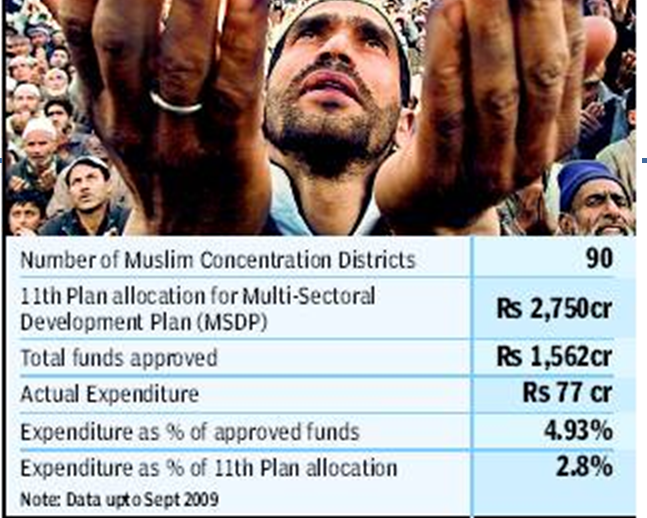Minorities and developmental schemes: India
(→Plan funds for Minorities: India) |
|||
| Line 11: | Line 11: | ||
[[Category:India|P]] | [[Category:India|P]] | ||
[[Category:Government|P]] | [[Category:Government|P]] | ||
| − | [[Category:Development| | + | [[Category:Development|P ]] |
[[Category:Name|Alphabet]] | [[Category:Name|Alphabet]] | ||
Revision as of 15:57, 2 March 2014
This is a collection of articles archived for the excellence of their content. Readers will be able to edit existing articles and post new articles directly |
Plan funds for Minorities: India
Only 5% of Plan funds spent on minorities Ambitious Scheme Launched To Provide Better Housing, Education Comes A Cropper
One of the significant steps of the first UPA government was to initiate action on the festering issue of exclusion and backwardness amongst minority communities in India, especially the Muslims. As the Sachar Committee had revealed in November 2006, Muslims had a shocking poverty rate of over 31% (compared to
the national average of about 22%) and, at 15%, unemployment among Muslim graduates was double that of the majority community.
Representation in civil services, central and state government service, armed forces and judiciary was less than 5% (though Muslims make up over 13% of the population) and ownership of assets or land was proportionally less than others. Clearly, special attention was needed to set this situation right.
The UPA government created a new ministry of minority affairs in 2006 to implement a slew of schemes addressing the problems of backwardness and poverty among Muslims primarily, but also among other minorities. Prime Minister Manmohan Singh announced a refurbished 15-point program for educational and vocational deficits among Muslims. In 2007, the government surveyed and identified 90 Muslim concentration districts (MCDs). An ambitious multi-sectoral development plan (MSDP) was launched to provide better housing, sanitation, education, healthcare, credit facilities, employment opportunities etc to minority community members.
MSDP has emerged as the chief vehicle of delivering the UPA government’s promises to remove the developmental deficit of the Muslim community out of the total allocation of Rs 1,756 crore to the ministry of minority affairs in 2009-10, the MSDP alone drew Rs 889.5 crore, that is, over 56% of the ministry’s funds. A performance analysis of this ambitious scheme, done by the Centre for Budget and Governance Accountability (CBGA), shows that it appears to be floundering.
Of the 90 Muslim concentration districts, 16 have yet to formulate a plan under MSDP. As of September 2009, project activities worth Rs 1,562 crore had been sanctioned for the remaining 74 districts, but only Rs 77 crore had actually been spent, according to data collected by CBGA. That’s just 5% of the total sanctioned amount. For the 11th Plan (2007-12), a total of Rs 2,750 has been set aside for the MSDP. After half the period has already gone by, the expenditure amounts to just 2.8% of the total.
As per a later but incomplete report of the Data Monitoring Unit of the ministry, covering 44 of the 90 MCDs, expenditure till December 2009 had improved slightly, but still stood at a shocking 17% of the total funds available with the districts. In most states, funds for 2009-10 were being released in December 2009.
For current year, just 3,201 houses had been built out of a target of 205,260 for Muslim families, under the Indira Awas Yojana, just 1,523 handpumps had been installed out of the targeted 14,020, only 5 health centers had been built from a target of 1,715, and only 20 anganwadi centers had been built out of 18,970 targeted, according to the ministry’s report.
The main reason behind the pathetic performance is lack of trained and adequate staff, infrastructure and planning at the district and state levels, says CBGA. While involvement of panchayati raj institutions may give the needed impetus to implementation, the UPA government needs to do a reality check on its lofty promises.
UPA’S Minority Report
